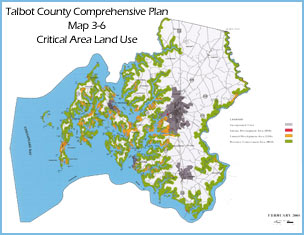Maryland’s Critical Area Program is unique not only because of the significant resources that it is designed to protect, but because it is one of only a few regulatory land use programs in the country that involve a cooperative implementation effort between State and local governments. The purpose of this arrangement is to provide local governments with the flexibility needed to address the unique physical, economic, and social characteristics of the particular jurisdiction while ensuring that the goals, purposes, policies, and criteria of Maryland’s Critical Area Program are implemented in a consistent and uniform manner throughout the State.

A Partnership Involving the State and Local Governments
Each jurisdiction with its own planning and zoning authority adopted its own local Critical Area program based on the Criteria promulgated by the Commission. The Critical Area Law recognized the primary responsibility of local governments for land use decisions. By implementing the Law in this fashion, local governments were allowed to add to or modify existing zoning and land use regulations, providing the flexibility necessary to accommodate local conditions. As a result, most jurisdictions’ Critical Area Programs differ substantially from one another.
Local Critical Area Program Development
Each local government was required to develop and submit a program to the Commission by March 1987; and these local programs were to be reviewed, amended, and approved by the Commission by June 1988. The deadline for submittal to the Commission was extended but many jurisdictions did not meet the deadline Ultimately, after many months of intense effort by the Critical Area Commission and local governments, all jurisdictions that were required to have a local program, had one in place by 1990.
The Critical Area Law requires local governments to review their Critical Area programs comprehensively every six years. These reviews are necessary for the Commission to make sure that local programs are kept up to date and that required legislation is incorporated into local codes and ordinances. The reviews also provide an opportunity for local governments to work closely with the Commission to modify provisions of their programs to accommodate new State or local plans or initiatives and to address any specific implementation challenges that they are facing. In addition to changes that are regularly made to local plans and ordinances, many jurisdictions are in the process of revising their Critical Area Maps and converting them to an electronic format. This enables local governments to make use of state-of-the-art technology and provides opportunities to make these resources more accessible to the public.
Local Critical Area Program Implementation
In general, for all development activities on private lands or lands owned by a local government, the local planning and zoning department is the primary agency responsible for reviewing and approving building permits, site plans, and subdivision plans. Private landowners do not have to apply to the Critical Area Commission for approval of development plans or building permits. The Commission does perform an oversight role with respect to local review of projects. Comments and recommendations on such projects are provided to the local government by the Commission in order to aid the local government in the decision-making process.
The Commission also does not function as an independent enforcement authority and does not have its own inspectors. Instead, the Commission works cooperatively with local enforcement officials to assist them in effectively administering and implementing their local Critical Area regulations. In 2004, the Critical Area Law was amended to allow local governments to request assistance from the Office of the Attorney General through the Critical Area Commission to provide assistance in pursuing and remediating serious violations.
The provisions of Maryland’s Critical Area Program are intended to provide general information about the basic requirements and standards included in the Critical Area Law and Criteria. However, it should be noted that each local government has its own locally implemented program, and this guide is not a substitute for local ordinances, codes, regulations, and policies that may be more specific and detailed.
